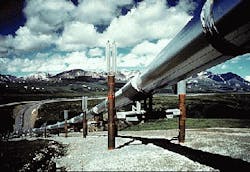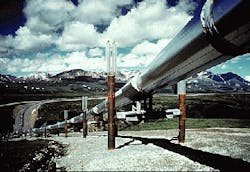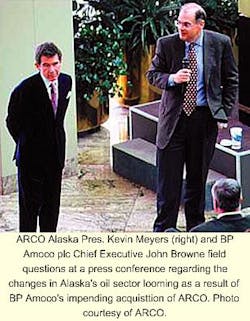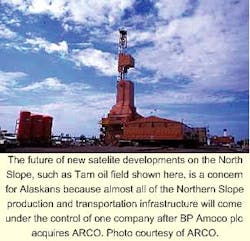ARCO discovered Alaska's first commercial oil field, at Swanson River. It was ARCO that, along with Exxon Corp., drilled the initial discovery well at Prudhoe Bay. And it was BP that confirmed the extent of the Prudhoe strike, the biggest field in North America. The two firms have shared operatorship of the Prudhoe Bay Unit (PBU), each operating half of the unit. And the two have been responsible for discovering and developing the vast majority of the oil and gas reserves discovered to date on Alaska's North Slope since the Prudhoe strikes. The combination also creates a significant consolidation of ownership interests in the Trans-Alaska Pipeline System (TAPS), which transports almost 20% of U.S. crude oil production.
While mergers of giant oil companies always raise antitrust concerns-and BP Amoco-ARCO is no exception-these two firms' dominance of Alaska's oil and gas sector has raised alarms within that state. At least one grassroots consumer organization has been formed to put severe restrictions on the combined company within Alaska. And some environmental lobby groups have complained that the combined company might not uphold the extensive environmental commitments for which ARCO has always enjoyed a sterling reputation in the state.
There are also concerns about how the merger will affect the outlook for marketing Alaska's vast, stranded natural gas reserves, with talk of various scenarios suddenly reemerging as a hot-button issue in the state.
While ARCO continues to press its production, development, and exploration initiatives in Alaska as an essentially independent company until the merger is effective, BP Amoco is pulling out all the stops in a public relations and communications campaign to reassure Alaskans that the merger will prove to be a genuine boon for the state.
Competition concerns
In response to the announcement of BP Amoco's impending acquisition of ARCO, Alaska Gov. Tony Knowles put together a task force to analyze the deal's impact on the state and to determine what the state's options are.
In June 30 testimony before the U.S. Senate committee on energy and natural resources, Alaska Att. Gen. Bruce Botelho noted that the task force had not yet finished its analysis but provided an overview of the analysis.
He noted that BP now owns 51% of TAPS and holds a similar percentage of PBU interests, while ARCO owns 22% of TAPS and holds a corresponding interest in PBU.
"ARCO, though smaller in Alaska than BP, has competed vigorously with BP in bidding for and developing new oil fields on the North Slope," Botelho testified. "Looking at the last 10 years of lease sales, ARCO is by far the leading high bidder.
"With the mergerellipsethe two large oil companies that have been the major competitive rivals in Alaska's oil company would become oneellipseThe potential impacts on the oil and gas industry in Alaska and thus on Alaska's economy and its citizens, are major."
While the task force's analysis is at the core an antitrust investigation, Botelho said, the major concerns break down into six issues:
- Leasing of North Slope lands. After the combination, BP Amoco, as principal owner of the North Slope infrastructure and the one company with available tanker space, would have appear to have a significant advantage in future bidding. And it would be the only company with access to the results of almost all the seismic work done to date on the slope.
- Access to field facilities. "At this time, BP and ARCO own or control all of the North Slope production infrastructure," Botelho said. "Other producers must negotiate with the companies to obtain access to those facilities, but the presence of two companies creates at least the potential for competition and a fair deal. Without that competition, would other producers have access to these facilities, and at what price?"
- Competition on TAPS. What adverse effects might the combination have on incentives for TAPS tariff competition, and what remedies are available in response to those effects?
- Marine transportation. Currently, BP Amoco, ARCO, and Exxon Corp. all own or lease tankers to transport Alaskan North Slope crude to market. The sales price that smaller slope producers receive reflects the cost of marine transportation. The concern here is that, if the combination raises transportation costs or if there is a lack of tanker capacity, that might discourage smaller producers or new entrants from making new investments in North Slope development.
- Oil value analysis. If the combination affects West Coast retail gasoline prices, and, in turn, West Coast spot crude oil prices, then that becomes a big concern for the state, because, for production tax purposes, all internal company transfers are taxed against an index of West Coast spot prices.
- Impact on gas development. ARCO has a much larger stake in North Slope gas resources than does BP and has committed funds to study the feasibility of building a gas pipeline to tidewater and exporting the gas as LNG. The task force is looking at what effect the combination would have on proceeding with the feasibility study and, ultimately, with development and production.
Another witness at the Senate committee hearing, Drue Pearce, president of the Alaska state senate, expressed concern about the greater concentration of BP Amoco's purchasing power on the North Slope: "Given BP Amoco's well-earned reputation in the industry for being an aggressive cost-cutter, many companies in the energy field services sector fear that BP Amoco may use its enhanced purchasing power to fundamentally reshape the oil field services sector in Alaska, leading to company failures, job losses, and/or jobs leaving the state."
Transportation concerns
A whole new cluster of concerns have arisen over transportation and marketing of North Slope oil and gas, in part a response to the looming disappearance of ARCO into BP Amoco.
Environmental groups have questioned whether the combined tanker fleets will remain as committed to safety as has ARCO, whose fleet will be consolidated later this year with two fleets under a new company.
These groups contend that ARCO was a leader in tanker safety initiatives with better crew training, advanced tanker design, and improved tug escorts. BP Amoco has responded to those claims by pointing to its own good record on tanker safety.
Meanwhile, environmental groups have called for a federal audit of TAPS, which is operated by the jointly owned (by Prudhoe Bay interest owners) Alyeska Pipeline Service Co., citing the drastic change in ownership and the recent claims by former Alyeska employees that the pipeline suffers critical maintenance problems that seldom are reported. The U.S. government audited Alyeska and TAPS operations in 1993 and 1995, and Alyeska contends another audit is unnecessary.
The final-and most contentious North Slope transportation issue-centers on ways to bring stranded North Slope gas to market. In recent weeks, those long-discussed scenarios were marked by upheaval.
For over a decade, Anchorage-based Yukon Pacific Corp. (YPC), a unit of CSX Corp., has led an effort to study the feasibility of building a gas pipeline roughly parallel to TAPS across Alaska to tidewater in the southeastern part of the state. Plans call for building a liquefaction plant and LNG export terminal at the gas line's terminus for shipping the North Slope gas as LNG to Asia. The project was originally estimated to cost $12 billion. But the project's high costs and uncertainty over LNG markets have kept it on the back burner.
YPC last year joined with ARCO Alaska Inc., Phillips Petroleum Co., Foothills Pipe Line Ltd., and Marubeni Corp. in an effort to get the long-delayed project off the ground. YPC has since split off from the group in a dispute over whether to locate the LNG facilities at Valdez (YPC's preference) or in Cook Inlet. YPC still holds leases at Valdez for the pipeline and LNG facilities.
Meantime, several Alaska municipalities along the TAPS (and presumably the gas line's route) are seeking to establish a port authority to operate the gas line. This would deliver significant tax breaks and bond-financing opportunities to the project, perhaps making the difference in terms of commerciality, the mayors contend.
What has further muddled the picture is BP Amoco's own initiative to pursue a gas-to-liquids (GTL) project to convert North Slope gas to liquids and then ship those liquids via TAPS, where throughput has been steadily declining for a number of years. While that might seem to be a setback for promoters of the gas line, BP Amoco contends the North Slope gas resource is big enough to support both such projects.
BP Amoco view
Describing the BP Amoco-ARCO deal as "a compelling strategic and geographic fit of quality assets," BP Amoco Chief Executive John Browne said it would yield annualized pretax synergies of around $1 billion by 2001.
The deal will substantially boost BP Amoco's reserves and production, giving it the largest oil output of any non-state company, and will consolidate its position in Alaska, where the resulting synergies and cost-savings are likely to increase the region's competitiveness and significantly encourage future investment, he contends.
"For BP Amoco, the strategic rationale for this deal is the immense potential it offers for future growth," Browne said. "In Alaska in particular, the synergies we can achieve from combining our operations will greatly increase the competitiveness of the state in the face of uncertain oil prices and provide a strong incentive for significant investment in existing and future fields."
In Alaska, Browne said the deal could help unlock the potential for large volumes of gas that "are currently uneconomic to develop but could make an enormous contribution to the energy needs of the next century.
"We have proprietary BP Amoco technology that we believe may allow us to convert some of that gas into liquids that can transported through the existing oil pipeline. We have plans to build a $70 million pilot plant on the North Slope to test that technology, and, if it is successful, we will consider full-scale development."
BP Amoco said the $1 billion synergies-which are on top of the $500 million cost-savings already targeted by ARCO-would be achieved from: a mix of organizational efficiencies; more focused exploration; improved business processes, including information technology; and rationalization of operations. About $710 million of the synergy savings are expected from exploration and production, including $200 million from streamlining Alaskan operations. About 2,000 jobs are expected to be lost as a consequence of merging the operations of the two companies, with the impact likely to be concentrated on locations in the Lower 48.
Browne said ARCO's assets would be absorbed with minimal impact to the BP Amoco organizational structure. The team planning the integration would be "ring-fenced" so that the deal does not interfere with the continuing integration of BP and Amoco assets-which he said is progressing more rapidly than expected and is likely to be concluded during the year. The company said that closure of the ARCO transaction is currently estimated to occur near yearend.
ARCO responds
Officials of both companies have mounted a campaign to get the word out to Alaskans-and, by proxy, the rest of the world-about the benefits of their impending combination to the state's and to the future of oil and gas exploration and production on the North Slope.
In testimony before the Alaska legislature in June, ARCO Alaska Pres. Kevin Meyers, offered his contention that the merger will benefit the state: "It will be positive because combining ARCO Alaska and BP Amoco will allow the restructuring of our Alaskan operations, which will eliminate duplication, lower operating costs, and create new opportunities for growth on the North Slope.
"The result will be more capital spending, greater ultimate oil recovery, higher production, and more state revenue. Clearly this acquisition will bring short term pain, but it is also the key to a better future. Make no mistake, in today's tough business climate, continued consolidation of our operations on the North Slope is inevitable.
"North Slope oil production is half what it was a decade ago. To remain a viable industry and attract new investment, we must continue to reduce operating costs as production declines. I know many in the community are worried about how this change will affect our suppliers and contractors. Others are concerned about the job losses that will result from the joining of our companies.
Meyers contended that even before BP Amoco's announcement that it would acquire ARCO, some kind of consolidation of North Slope operations was imminent.
"At the time news of this deal became public, ARCO and BP were engaged in serious discussions aimed at establishment of a single operator at Prudhoe Bay," he said. "This transaction delivers much more than that step, because it better aligns the interests of BP Amoco and the remaining PBU owners, while delivering slope-wide savings and efficiencies."
Meyers touted the ultimate benefits of such savings and efficiencies.
"You've all seen what can happen when we take cost out of our North Slope operations," he told the legislators. "Remember 1994: Oil prices had plummeted to $15/bbl, and ARCO Alaska's long-term plan showed year after year of declining North Slope production. To survive, we had to make some difficult changes. We began by eliminating 900 jobs.
"We changed the way we purchased goods and services, forging new agreements with suppliers and contractors. We used technology and facility-sharing agreements to reduce the cost of North Slope exploration and to lower operating and development costs. When we were done, we had reduced our total operating costs by 25%. We knew from the outset that those savings would go to our bottom line, allowing us to survive low oil prices.
"But more importantly, our new cost structure allowed us to pursue projects that weren't feasible before-projects like additional infill drilling in existing fields, MIX (miscible injectant expansion), West Sak (development), satellite exploration and development, and Alpine (development), which is setting a new standard in North Slope development.
"We challenged our employees to make the most of our new, lower cost structure and they delivered a plan for achieving 'No Decline After 99'(see related article, p. 38)."
"The result was a three-fold increase in the level of ARCO capital spending in Alaska. That investment is paying off. In 1998-for the second year in row-ARCO replaced every barrel it produced in Alaska. We also kick-started a whole new Alaska industry when we awarded contracts to two Alaskan companies for the fabrication of the first sealift-scale modules ever built in Alaska. And with the start-up of Alpine in 2000, we will deliver on 'No Decline After 99.'"
Meyers said that, over the long term, the merger will mean greater investment in Alaska, more exploration and discoveries, and increased production and state revenues.
"Prior to regulatory approval of this combination, ARCO will operate as an independent company," he said. "We will continue to pursue our plans for production growth in Alaska. Capital spending will not be reduced. Alpine will stay on track. We will continue to explore for new fieldsellipseWe will continue to put protection of the environment and the safety of our employees first in all we do."
New initiatives
Until government approval is secured, BP Amoco and ARCO will continue to operate as separate and independent companies, according to BP Exploration Alaska Inc.Pres. Richard C. Campbell: "Alaska will continue to be a cornerstone of our global activities, and our new combined organization will maintain the same high environmental, safety, and social standards that BP Amoco and ARCO have always maintained separately."
Campbell cited these initiatives to support his claims:
- BP Amoco will invest $5 billion in North Slope development over the next 5 years or so, which works out to an annual average that exceeds projected 1999 capital spending by ARCO and BP Amoco combined, as well as ARCO's and BP's combined capital spending during the past 5 years.
- BP Amoco will increase its financial support of community organizations by 50% from the current combined ARCO-BP Amoco level.
- BP Amoco will make the centerpiece of its global gas activities its efforts to commercialize North Slope gas. The company will continue the ARCO-led gas sponsor group, relocate its gas technology center to Alaska, and build a GTL pilot plant on the North Slope.
- "BP Amoco will honor all current agreements with ARCO's contractors and suppliers and will continue to treat all business partners fairly and equitably, with dignity and respect."
- Organized labor will continue to play an important role to BP Amoco's North Slope construction activities.
- BP Amoco will continue to work cooperatively and collaboratively with all levels of government.
- BP Amoco will honor ARCO's commitments to build new Millenium-class double-hull tankers and is fully committed to a tanker renewal program that complies with the Oil Pollution Act of 1990.
- BP Amoco will continue to be actively involved in state and federal lease sales and continue to pursue exploration and development opportunities in Alaska.
- BP Amoco will continue its efforts to provide job and business opportunities for Alaskans whenever possible: "BP Amoco will treat all employees with respect and dignity. The new organization will be designed to minimize disruptions and will be composed of about equal numbers of BP Amoco and ARCO personnel. Those who lose their jobs will receive generous severance packages."





